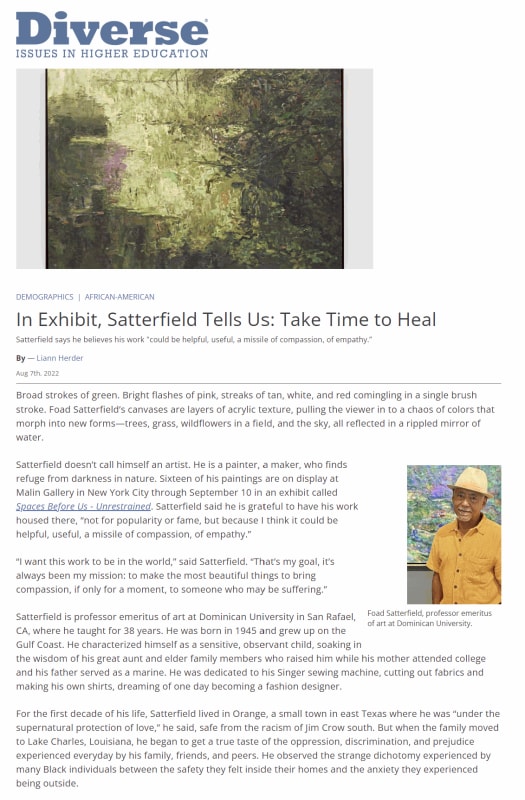Satterfield doesn’t call himself an artist. He is a painter, a maker, who finds refuge from darkness in nature. Sixteen of his paintings are on display at Malin Gallery in New York City through September 10 in an exhibit called Spaces Before Us - Unrestrained. Satterfield said he is grateful to have his work housed there, “not for popularity or fame, but because I think it could be helpful, useful, a missile of compassion, of empathy.”
“I want this work to be in the world,” said Satterfield. “That’s my goal, it’s always been my mission: to make the most beautiful things to bring compassion, if only for a moment, to someone who may be suffering.”
Satterfield is professor emeritus of art at Dominican University in San Rafael, CA, where he taught for 38 years. He was born in 1945 and grew up on the Gulf Coast. He characterized himself as a sensitive, observant child, soaking in the wisdom of his great aunt and elder family members who raised him while his mother attended college and his father served as a marine. He was dedicated to his Singer sewing machine, cutting out fabrics and making his own shirts, dreaming of one day becoming a fashion designer.
For the first decade of his life, Satterfield lived in Orange, a small town in east Texas where he was “under the supernatural protection of love,” he said, safe from the racism of Jim Crow south. But when the family moved to Lake Charles, Louisiana, he began to get a true taste of the oppression, discrimination, and prejudice experienced everyday by his family, friends, and peers. He observed the strange dichotomy experienced by many Black individuals between the safety they felt inside their homes and the anxiety they experienced being outside.
“There was always this fear of being out in the living world in a way, out in the woods. So, what I decided to do was to take that trauma and that fear and turn it in on itself,” said Satterfield. “When I was terrified or traumatized, I would go out into the woods, nature, and let nature take it from me and absorb it.”
Satterfield said he continues to find solace in nature, that nature "takes the poison out.” His outdoor meditations allow him to create paintings that are messages of “compassion, love, and forgiveness," he said.
His Woodfox series has particular poignance.
Satterfield made several compositions inspired and named for Albert Woodfox in 2016, the same year Woodfox was released from prison. Woodfox had been accused, along with two other Black men, of the murder of a prison guard in 1972. All three asserted their innocence and said they had been blamed because of their affiliation with the Black Panther party.
Woodfox would go on to spend 43 years in solitary confinement in Louisiana State Penitentiary, otherwise known as Angola. He would later publish a book about his experience, Solitary: Unbroken by Four Decades in Solitary Confinement. My Story of Transformation and Hope. Woodfox died on Thursday, August 4, from COVID-19 complications.
The inhumanity of Woodfox’s punishment tore at Satterfield's heart, he said. While activism and protest alleviated some of the pain, Satterfield found himself coming back to the same question: “What can I do?”
So, Satterfield went to the woods. He wandered to a quiet park near his home in Berkeley, CA, and sat down next to small cliff and a dried-up stream. He began to see the parallels between this space and the suffering of Woodfox.
“This has all the elements—a semblance of life almost being wiped out, life trying to restore itself but inhibited—and it’s a horizonal composition, laying down as opposed to standing up—all the decomposing and fertile materials, life and death existing in the same plane,” said Satterfield. “To transpose it into natural elements to tell that same story, you’ve got to get a chance to be in front of it for a minute.
That’s why Satterfield hopes his audience will take the time to sit and observe his paintings, to see what they can discover when given the permission for space, peace, and quiet.
Woodfox would go on to spend 43 years in solitary confinement in Louisiana State Penitentiary, otherwise known as Angola. He would later publish a book about his experience, Solitary: Unbroken by Four Decades in Solitary Confinement. My Story of Transformation and Hope. Woodfox died on Thursday, August 4, from COVID-19 complications.
The inhumanity of Woodfox’s punishment tore at Satterfield's heart, he said. While activism and protest alleviated some of the pain, Satterfield found himself coming back to the same question: “What can I do?”
So, Satterfield went to the woods. He wandered to a quiet park near his home in Berkeley, CA, and sat down next to small cliff and a dried-up stream. He began to see the parallels between this space and the suffering of Woodfox.
“This has all the elements—a semblance of life almost being wiped out, life trying to restore itself but inhibited—and it’s a horizonal composition, laying down as opposed to standing up—all the decomposing and fertile materials, life and death existing in the same plane,” said Satterfield. “To transpose it into natural elements to tell that same story, you’ve got to get a chance to be in front of it for a minute.
That’s why Satterfield hopes his audience will take the time to sit and observe his paintings, to see what they can discover when given the permission for space, peace, and quiet.

